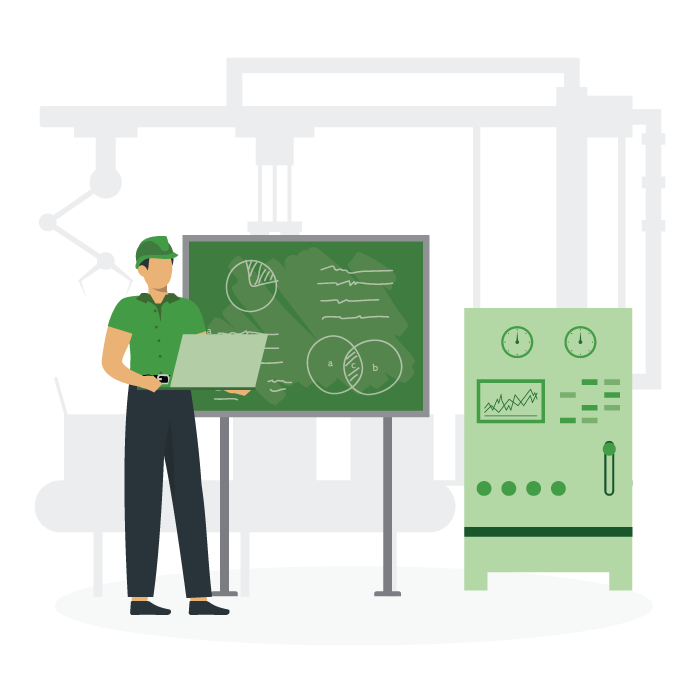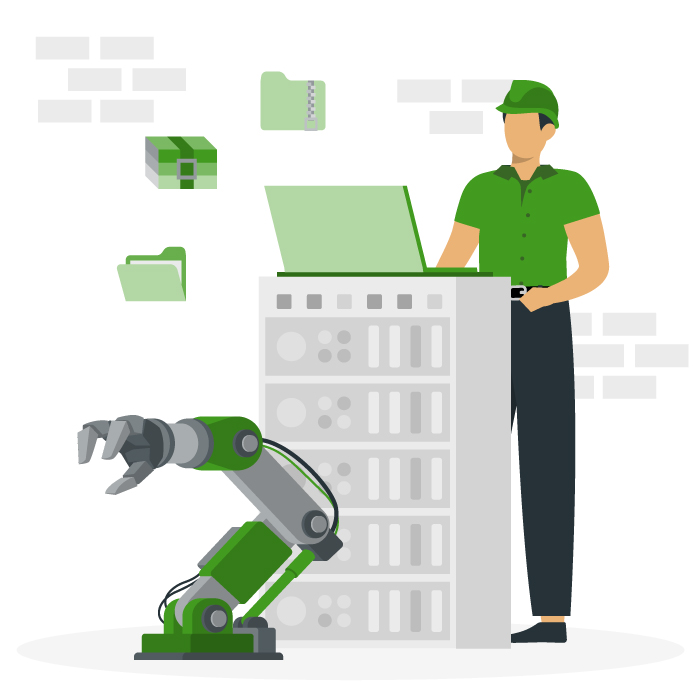Total Productive Maintenance
Everything you ever needed to know about total productive maintenance.
What is Total Productive Maintenance (TPM)?
Total productive maintenance (TPM) is a methodology designed to improve production systems by preventing problems. Its goal is to improve product quality, minimize delivery time, and reduce costs by eliminating:
- Equipment breakdowns
- Product defects
- Unplanned downtime
- Accidents
- Waste
TPM is an operating philosophy that enlists all company employees in a proactive, multilayered approach to maintenance.
Examples of Total Productive Maintenance
The TPM model
The TPM model starts with a set of company-wide principles called the 5-S Foundation.
That foundation supports the eight pillars of TPM — distinct techniques designed to assist and improve equipment reliability.
What is the 5-S methodology?
The 5-S methodology is an organizational technique derived from Japanese concepts of organizing space. By following the 5-S concepts, organizations can create high-quality work environments that enhance worker effectiveness, efficiency, and mental well-being. It also reduces waste and optimizes worker and equipment productivity.
Sort (Seiri)
Seiri involves thoroughly inspecting every item in a specific area to determine whether or not it contributes value. If an item doesn’t add value, it should be promptly eliminated.
When you can’t immediately remove the item, place it in a quarantine area or attach a red tag to signify the need for its later removal. Red-tagged items should be returned to their correct location, recycled, or disposed of. The working area must be clear of all materials except those essential for production.
Set in order (Seiton)
Seiton translates to orderliness. The aim is to make things easy to find, use, and replace by giving them a specific home. Orderliness includes placing frequently used items together in groups, close to the workforce. Items used less often are stored centrally.
Once set in order, a 5-S diagram shows the location of materials, tools, and objects. Companies use the diagram as a reference document for staff, to assist with training new hires, and as a method of tracking revisions to ensure documentation is kept up to date.
Shine (Seiso)
Seiso involves maintaining continuous cleanliness. The expectation is that workers will clean their workspace at least once every day, and conduct a thorough cleaning weekly. Those using the area are responsible for performing Seiso.
Workers gain ownership by taking responsibility for their equipment and workspace with the added benefit of noticing any problems, hazards, or missing equipment. These issues are then fed into the maintenance system for early rectification before they impact production.
Standardize (Seiketsu)
Seiketsu refers to standardizing the first three practices of 5-S — making sort, set in order, and shine standard procedures, and using schedules to mandate frequency and responsibilities.
The procedures use photos and visual management techniques to assist workers in maintaining these standards. By standardizing all five practices, they become integrated into the organization’s daily routine and form part of the quality management system, subject to regular audits.
Sustain (Shitsuke)
Shitsuke encompasses discipline and is about taking initiative, fostering a culture of continuous improvement, and committing to the preceding four concepts without the need for constant supervision.
Workers and management continue to support each other in striving for improvement through regular audits and training.
The 8 pillars of TPM
A business can begin to build the core of TPM once it has established the 5-S foundation. The eight pillars of TPM refer to tactical, targeted initiatives that eliminate waste and improve equipment reliability.
1. Autonomous maintenance
With autonomous maintenance, machine operators take on responsibility for their equipment by doing simple tasks like cleaning, lubrication, visual inspection, and minor maintenance. Assigning these duties to the operator enhances their skills and knowledge about the equipment.
Additional downstream effects for production include:
- Identifying and addressing problems early on improves production by preventing them from evolving into major maintenance issues or causing breakdowns.
- Machinery operates at an optimal level due to regular cleaning and maintenance.
- Maintenance personnel are able to focus on higher-level maintenance tasks, further improving equipment reliability and reducing downtime.
- Capital investment costs decline as equipment life extends.
2. Focused improvement
Focused improvement identifies waste or system losses and eliminates them using a cross-functional team-based approach.
A trained team will:
- Select a piece of equipment or a functional problem
- Focus on benchmarking current performance
- Identify all problems and agree on improvement goals
- Brainstorm solutions and implement them using a systematic process similar to the plan-do-check-act cycle
- Compare the final performance to the initial benchmark
Benefits of focused improvement include:
- Rapid production improvements from using a consistent and repeatable approach
- A broad base of employees trained in the technique
- More efficient processes, products, and systems
- Improved safety performance
3. Planned maintenance
Planned maintenance primarily involves scheduled maintenance tasks, which are scheduled at frequencies defined by the equipment’s condition, operating performance, or maintenance history. The schedule is based on actual data to ensure equipment is neither over nor under-maintained.
Planned maintenance provides many benefits:
- It reduces unplanned stoppages due to breakdowns, increasing production capacity.
- Production can be planned around maintenance in order to minimize their impact on output.
- Maintenance costs are reduced since there is no costly emergency maintenance.
- Machinery life is extended, reducing the need for capital investments.
- Product quality improves and rework rates decline.
- Planning for necessary maintenance improves your ability to manage inventory.
4. Early equipment maintenance
Early equipment maintenance, or early equipment management engages suppliers or equipment designers in planning for equipment implementation before it arrives. By considering their operating requirements ahead of time, the company can modify or improve the new equipment to ensure its seamless integration into the production environment.
This pillar stops many start-up issues that prevent new equipment from becoming productive as quickly as possible.
These issues can include:
- Component failures
- Procuring new tooling and spares
- Poor maintainability or operability
Benefits of early equipment maintenance include:
- Optimized equipment design
- Improved or additional safety features
- Faster installation
- Efficient equipment commissioning
- Improved or modified operability
- Improved access for ease of lubrication and maintenance
- Modifications to assist with easy cleaning and visual inspection
5. Quality maintenance
Quality maintenance uses a scientific approach to eliminate equipment irregularities and ensure defect-free manufacturing. It also emphasizes proactive rather than reactive maintenance and focuses on finding and rectifying root causes of an issue rather than treating its symptoms.
Maintaining equipment well prevents faults and downstream impacts that might require products to be scrapped or reworked. It minimizes quality issues, waste, and lost revenue due to production downtime.
6. Education and training
TPM is a people-centered approach, relying heavily on the knowledge, attitude, and engagement of all company staff. This pillar emphasizes the continual education and training of all employees to ensure their understanding and participation in TPM.
Examples of education and training include:
- Equipment operators being trained on their autonomous maintenance roles
- Maintenance staff improving their knowledge of preventative maintenance and reliability techniques
- Managers understanding their role in quality-improvement
7. TPM in the office
The TPM principles used on the manufacturing floor also apply to offices and boardrooms. This ensures all departments properly support the organization’s use of TPM in achieving its mission.
Requiring administration and management to practice TPM principles breaks down silo mentalities and develops interdepartmental cooperation. It also ensures a larger pool of expertise for cross-functional teams needed to implement other pillars, such as focused improvement or quality maintenance.
8. Health, safety, and the environment
While efficient and effective production is important, this must not be achieved at the expense of employee safety or environmental sustainability.
Total productive maintenance aims to eliminate all equipment breakdowns, product defects, and accidents. Health, safety, and the environment are integral to the philosophy.
Together, the eight pillars ensure the work of all employees and cross-functional teams constantly strive to create a safe working environment, while making them — and the equipment — more productive.
Why is Total Productive Maintenance important?
A well-designed and implemented TPM program improves equipment effectiveness and efficiency. It also has a measurable positive impact on other areas of a manufacturing business.
Direct benefits of TPM:
- Reduced manufacturing costs through the elimination of waste, rework, and rejections
- Improved equipment availability and performance
- Improved productivity through reduced idle time and small stoppages
- Improved product quality
- Fewer injuries and accidents
- Greater employee engagement
- Increased customer focus and satisfaction
Indirect benefits of TPM:
- Enhanced workplace culture
- Improved workplace conditions
- Greater teamwork
- Improved operator machine ownership
- Greater material and resource availability
Examples of successful TPM implementations
Two businesses found great success after implementing TPM in their companies. Here are the highlights and results for each.
Tata Steel Tubes (TST)
TST began implementing TPM in 2001. The goal of TPM implementation was to:
- Maximize overall equipment effectiveness
- Achieve 100 percent delivery compliance
- Reduce cycle time in all processes
- Attain industry leadership on cost and quality
Within five years, the results revealed the following improvements:
- 78% improvement in productivity (tonnes/month)
- 92% improvement in productivity (tonnes/man/year)
- 59% improvement in overall equipment effectiveness
- 63% reduction in equipment breakdowns and failures
- 85% reduction in customer complaints
- 22% improvement in delivery compliance
- 140% increase in operating profits
- 80-90% reduction in rejections
- Zero major accidents
- 80% reduction in minor accidents
- 10% improvement in plant yield
Asella Malt
Asella Malt, in Ethiopia, conducted a six-month pilot project at the start of 2011 to assess the value of TPM. Because the boiler plant is a major bottleneck in malt manufacturing, the study focused on this equipment and benchmarked productivity and OEE at the beginning.
By June 2011, Asella Malt’s OEE had improved from 70.35% to 80.23%, with a reduction in total losses from 64.48 hours in January to 23.55 hours in June — a 63.5% reduction.
Want to see Limble in action? Get started for free today!
Managing TPM with a CMMS
A Computerized Maintenance Management System (CMMS) is an essential tool in applying TPM to your organization, giving you reliable, clean, and real-time data to maximize the program’s effectiveness.
From benchmarking current performance to analyzing OEE and implementing a planned maintenance program, A CMMS provides access to all the equipment information and data your team needs. When used with an analytics engine, a CMMS will also alert operators when an asset reaches preset thresholds, allowing for replacement or repair before a stoppage occurs.
Is Total Productive Maintenance right for you?
TPM is more than simply a maintenance strategy; it is a comprehensive operating strategy that demands a cultural shift to maximize production efficiency, quality, and effectiveness.
Through a team-based focus on continuous improvement, TPM maximizes equipment productivity while creating a safer and happier working environment. If you want to find out more about how to implement a TPM with the help of a CMMS, start a free trial or reach out to our support team to learn more.


